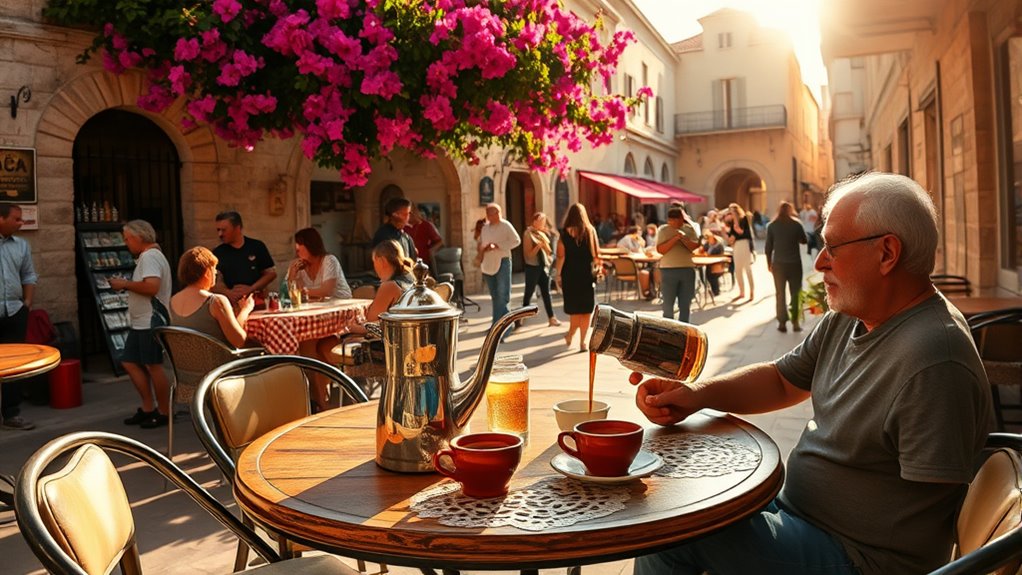Sardinian coffee culture is a vibrant mix of tradition, community, and regional flavor. You’ll notice how locals turn coffee into a social ritual, gathering at cafés and sharing moments over expertly prepared brews. From historic venues to unique blends, the island’s coffee scene reflects its rich history and strong sense of belonging. If you want to explore the fascinating stories and customs behind Sardinian coffee, there’s much more to discover.
Key Takeaways
- Sardinian coffee culture emphasizes social rituals, with coffee serving as a key community bonding and hospitality tradition.
- Historic cafés and local roasting techniques preserve Sardinia’s unique coffee identity and cultural heritage.
- Regional preferences favor traditional brewing methods like Moka pots, highlighting craftsmanship and flavor profiles.
- Coffee bars act as social hubs, fostering community exchange and reducing social isolation among residents.
- The industry supports economic growth through tourism, artisanal shops, and regional markets, promoting cultural identity.
The Historical Roots of Coffee in Sardinia

Have you ever wondered how coffee first found its way to Sardinia? Back in 1938, coffee was a rare and costly luxury, mainly accessible to a select few due to high raw material prices and limited local roasting facilities. It wasn’t until Giuseppe and Carmela Murgia opened their roasting shop in Cagliari that Sardinia began its modern coffee journey. Before that, coffee’s presence was minimal compared to mainland Italy, where it arrived via Mediterranean trade routes in the late 16th century. Its scarcity made it a special treat reserved for visitors and the elite. It wasn’t until the 1970s, with industrial advancements, that Sardinia’s coffee production expanded, transforming coffee from a rare luxury into a more accessible regional staple. The company’s growth over the years reflects a dedication to quality and innovation. Additionally, the adoption of local roasting techniques helped solidify Sardinia’s unique coffee identity within Italy.
Coffee as a Social Ritual and Community Bond
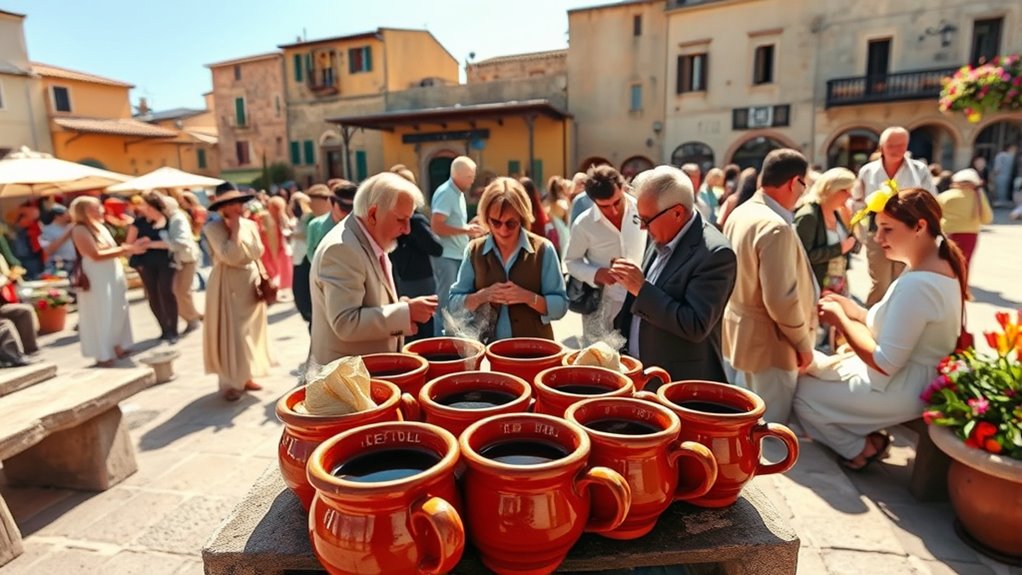
You’ll notice that in Sardinia, coffee isn’t just about drinking; it’s about connecting. Sharing a quick espresso at the bar or enjoying a slow moment together reinforces community bonds and daily routines. These rituals turn coffee into a powerful symbol of hospitality and social cohesion. Regional traditions often dictate the specific ways in which coffee is enjoyed and shared, highlighting its importance in Sardinian culture. The social aspect of coffee is further emphasized by the traditional preparation methods that enhance the communal experience.
Coffee as Social Catalyst
In Sardinia, coffee serves as a powerful social catalyst, transforming ordinary moments into opportunities for connection and community. When you visit a local coffee bar, you’re entering a vibrant hub where neighbors, friends, and even strangers mingle effortlessly. These spaces aren’t just places to buy coffee; they’re communal arenas for informal chats, business talks, and cultural exchanges. Baristas often become trusted figures, remembering your preferences and participating in neighborhood life. The quick exchanges at the bar foster countless micro-interactions that strengthen social bonds daily. Whether standing or seated, everyone shares in the collective experience, breaking down social barriers. Coffee acts as a unifying force, creating a sense of belonging that transcends individual differences, making community life richer and more interconnected. Regional customs influence Sardinian coffee interactions, emphasizing the local importance of shared routines and traditions. Additionally, the ritual of sharing coffee often involves specific gestures and conversations that reinforce social cohesion.
Rituals of Daily Bonding
Daily coffee rituals in Sardinia serve as meaningful moments of connection that reinforce community bonds and cultural traditions. Mornings begin with shared coffees like cappuccino or latte macchiato, enjoyed before 11 am to preserve appetite and foster a gentle communal start. These routines reflect respect for technique, tradition, and daily rhythm, whether at home or a local café. Coffee after meals offers a sacred pause, strengthening bonds through espresso or caffé corretto. Serving coffee to guests signals warmth and hospitality, creating a sense of inclusion. The tradition of sharing coffee is deeply rooted in Sardinian history, emphasizing its role in fostering social cohesion and cultural identity. Coffee rituals also promote a sense of belonging, strengthening communal ties through shared experiences. Imagine the scene:
| Setting | Coffee Type | Social Moment |
|---|---|---|
| Family kitchen | Cappuccino | Morning bonding |
| Town café | Espresso | Post-meal reflection |
| Piazzas | Latte macchiato | Community gathering |
These rituals deepen relationships, weaving coffee into Sardinian life.
Traditional Coffee Preparation Techniques in Sardinia
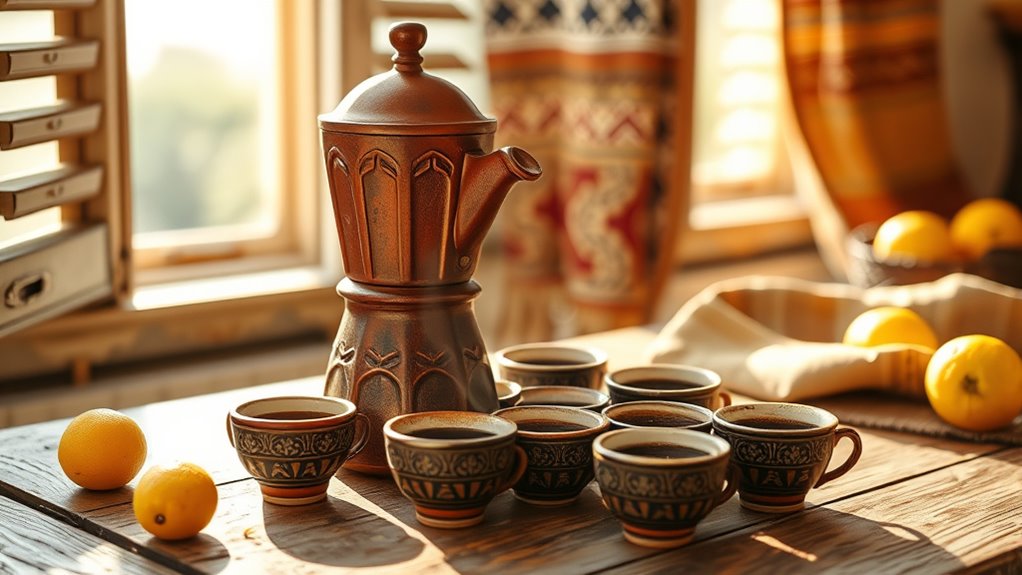
Traditional coffee preparation techniques in Sardinia reflect a deep respect for craftsmanship and local customs. You’ll notice that farmers select only ripe coffee cherries, ensuring each batch is top quality. The roasting process, lasting 12 to 15 minutes, brings out the beans’ natural flavors and is often done using traditional methods, like those at La Tazza d’Oro. For brewing, Sardinians favor equipment such as Moka pots, French presses, and espresso machines, each chosen for their ability to produce rich, full-bodied coffee. The focus remains on high standards—careful bean selection, precise roasting, and skillful brewing—to guarantee a superior cup. These techniques embody a tradition passed down through generations, emphasizing authenticity and a deep connection to Sardinian cultural identity. Additionally, the use of proper brewing techniques ensures that the coffee’s aroma and flavor are fully developed, highlighting the importance of skillful preparation.
The Role of Coffee Bars in Sardinian Society
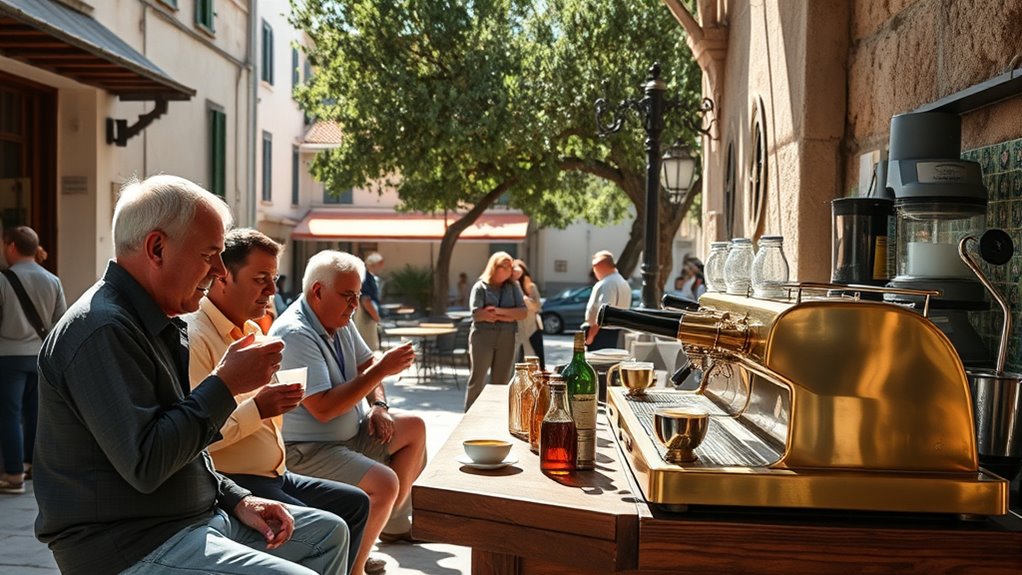
Coffee bars in Sardinia are more than just places to grab a drink; they serve as essential social hubs that bring communities together. You’ll find these spaces acting as informal forums where locals exchange news, discuss local matters, and strengthen neighborhood bonds. They also help combat social isolation, especially among older adults, supporting mental well-being. Picture these scenes:
Coffee bars in Sardinia connect communities, foster conversations, and combat social isolation, enriching local life and culture.
- Quick chats at the counter, fostering everyday social interactions.
- Entrepreneurs holding informal meetings, boosting local business.
- Artists and thinkers gathering to exchange ideas and culture.
In these environments, social etiquette and routines promote short, meaningful encounters. Baristas play a key role, remembering your name and preferences, making each visit a necessary part of Sardinian community life. Additionally, the presence of dedicated social spaces like coffee bars encourages community engagement and cultural exchange.
Iconic Coffee Venues and Their Cultural Significance
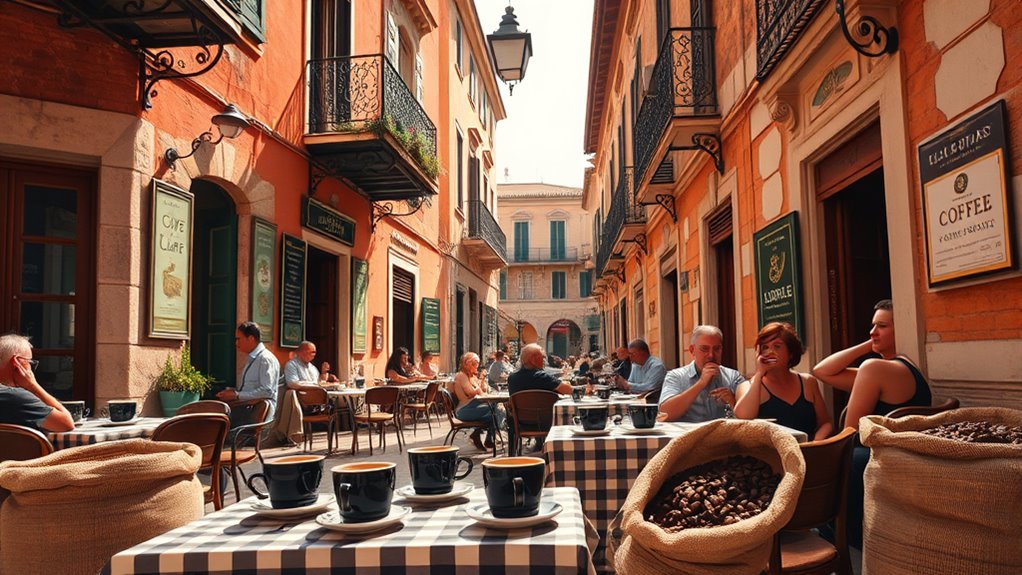
In Cagliari, a handful of historic cafés stand out as enduring symbols of the city’s rich cultural heritage. Caffé Svizzero, founded in 1901, is notable for its underground chapel and Swiss roots, reflecting European influences. Antico Caffè, established in 1838 by Ligurian trader Lazzaro Canepa, became a hub for literary figures like Grazia Deledda and Gabriele D’Annunzio, embodying Sardinia’s cultural identity. Caffé Tramer, opened in 1857, retains its original décor and is recognized as a regional historical site, serving as a testament to 19th-century social life. These venues were more than cafés; they were social and artistic centers where performances, intellectual debates, and cultural exchanges flourished. Their architecture and history make them essential symbols of Sardinia’s vibrant café culture and heritage. These cafés continue to preserve their historic charm while adapting to modern times, ensuring their legacy endures for future generations. Additionally, the historic significance of these venues highlights their importance in understanding Sardinia’s social evolution over time.
Regional Variations and Unique Sardinian Blends

Sardinia’s unique coffee scene is shaped by both regional preferences and the island’s access to global bean varieties, resulting in distinct blends with characteristic flavor profiles. You’ll find a variety of imported beans, each offering unique tastes. For example:
- Santos beans deliver a full-bodied flavor with balanced acidity.
- Antigua beans are prized for their aroma and sweetness.
- Sidamo beans provide fruity, floral, and tropical notes.
These beans are roasted with care, balancing tradition and modern techniques to preserve their distinctive qualities. Sardinian roasters craft blends that emphasize sweetness, acidity, and body, often combining vanilla, citrus, cacao, and fruit flavors. This creates a rich, complex coffee experience that reflects both the island’s cultural influences and dedication to quality. Regional diversity also plays a significant role in shaping Sardinian coffee preferences, influenced by cultural influences and the island’s unique geography.
The Economic Impact of Coffee on the Island

You can see how coffee fuels Sardinia’s economy by creating jobs in cafes, distribution, and support industries. As local markets grow, more visitors and residents spend money at coffee shops, boosting tourism revenue. Additionally, the rise of artisanal coffee shops highlights how the island is expanding its unique coffee culture while strengthening its economic future. Coffee production and consumption on the island also contribute significantly to local employment and income levels, with specialty coffee shops emerging as a key driver of this growth.
Local Market Growth
How does coffee fuel Sardinia’s local economy? It’s mainly through roasting and retailing, since cultivation is limited. This creates jobs beyond farming, supporting small and medium enterprises. Sardinian roasters focus on traditional Italian techniques, targeting regional and mainland markets. The local industry helps keep more economic value on the island by reducing imports. Here’s a snapshot:
- Employment in roasting and retailing: Small businesses thrive, offering jobs and boosting local income.
- Market preferences: Coffee shops and cafés in towns generate steady demand, supporting surrounding retail sectors.
- Import reliance and export potential: Sardinia benefits from Italy’s larger coffee export growth, with niche markets like specialty coffee offering future growth opportunities.
- The industry’s growth is also influenced by market volatility and consumer trends, which can impact prices and demand.
This vibrant market sustains local economies, independent of tourism fluctuations.
Tourism Revenue Boost
Coffee culture especially boosts tourism revenue in Sardinia by attracting visitors enthusiastic to experience authentic local flavors and traditions. International tourist spending hit around €1.67 billion in 2023, a 50% rise from 2019, driven partly by coffee-related tourism. Tourists from the U.S. have doubled since the pandemic, drawn by Sardinian coffee experiences, increasing overall spending. Café prices, from €1-2 stand-up to €3-4 seated with views, encourage frequent purchases, supporting local income. Premium pricing in hotspots like Costa Smeralda signals a luxury coffee market, while lower restaurant prices elsewhere boost volume-based spending. Coffee-related festivals, tastings, and cultural events attract niche tourists, extending stays and increasing daily expenditures. These activities, along with partnerships between artisans and tourism bodies, strengthen Sardinia’s reputation as a rich coffee destination.
Artisanal Coffee Expansion
Have you noticed how Sardinia’s growing artisanal coffee scene is transforming the local economy? This expansion boosts demand for specialty beans and roasting skills, creating new opportunities. Small-scale producers support local farmers and preserve traditional methods like hand-picking. Here are three ways it impacts the economy:
- Job creation across farming, roasting, and retail sectors, including micro roasteries and cafés.
- Increased income for farmers and producers through higher-value, premium coffee sales.
- Economic distribution across both rural and urban areas, fueled by investments from small enterprises. Farmers’ love and expertise shape an authentic farm-to-cup experience.
As the artisanal sector grows, it aligns with global trends for ethically sourced, high-quality coffee. This not only benefits local producers but also attracts niche consumers seeking unique Sardinian flavors, strengthening the island’s economic and cultural identity.
The Influence of Italian Coffee Culture on Sardinian Identity

Italian coffee culture has profoundly shaped Sardinian identity by embedding shared rituals and social practices into daily life. When you visit Sardinian cafés, you’ll notice how espresso is more than a quick drink—it’s a symbol of Italian robustness and sophistication. Sardinians adopt the Italian custom of standing at bar counters, making coffee breaks social moments that foster community and reflection. The invention of the espresso machine and Italy’s rich coffee heritage influence local preparations, linking Sardinia to Italy’s cultural pride. Espresso machines revolutionized coffee brewing, and Italy’s rich coffee heritage influences local preparations, linking Sardinia to Italy’s cultural pride. Coffeehouses serve as social hubs where ideas are exchanged, echoing Italy’s historic cafés. This shared ritual of enjoying espresso unites Sardinians with national traditions, reinforcing a sense of belonging and cultural pride rooted in Italy’s longstanding coffee legacy.
The Future of Coffee Culture in Sardinia

As Sardinia continues to embrace its rich coffee traditions, emerging trends and market dynamics are shaping its future landscape. You can expect increased demand for premium and specialty coffees, driven by Italy’s overall market growth projected to reach US$4.81 billion by 2033. This growth will likely lead to:
- Expansion of café chains and modern retail formats, influencing local coffee options.
- A shift toward sustainable practices, including responsible sourcing and eco-friendly packaging.
- Greater focus on specialty brews, blending traditional espresso with innovative offerings to attract younger consumers.
Technological advances like direct trade platforms and climate-resilient coffee varieties will help ensure supply stability. Italy’s coffee market imported over 670,000 tonnes of green coffee in 2022, underscoring the importance of sustainable sourcing and supply chain resilience. Overall, Sardinian coffee culture is poised to evolve through sustainability, innovation, and market expansion, shaping a vibrant future.
Frequently Asked Questions
How Do Sardinian Coffee Preferences Differ From Mainland Italy?
You’ll notice that Sardinians prefer espresso and enjoy it slowly in social settings, unlike mainland Italians who often have quick, on-the-go coffee. They rarely drink coffee at home, frequent local bars, and savor their drinks after meals or throughout the day. Sardinian coffee is linked to community, tradition, and health, with local brands enhancing a unique cultural identity, making their coffee experience more about connection than speed.
Are There Specific Local Ingredients Used in Sardinian Coffee Blends?
You ask if specific local ingredients are used in Sardinian coffee blends. While Sardinian blends focus on imported beans roasted locally, they typically don’t include unique local ingredients like herbs or spices. Instead, the culture emphasizes high-quality beans and traditional preparation. The region enhances the coffee experience with local sweets, dairy, or liqueurs like Mirto, but the blends themselves remain pure, highlighting the rich, full-bodied flavor Sardinians prefer.
What Role Do Women Play in Sardinian Coffee Culture?
You might think coffee just sits in a cup, but women hold the secret to its soul! They’re the master brewers at home, passing down recipes and customs that make every sip a tradition. In cafes, they’re the lively heartbeat, serving with warmth and charm, and guiding social rituals. From spirits to conversations, women are the true custodians of coffee’s cultural magic, weaving community and history into every cup.
How Has Tourism Influenced Sardinian Coffee Customs?
Tourism has markedly shaped Sardinian coffee customs by bringing in visitors keen to experience authentic traditions. You’ll notice local cafes showcase traditional brewing techniques and offer demonstrations, encouraging a lively exchange of culture. Tourists’ interest motivates producers to preserve and adapt their rituals, blending authenticity with modern tastes. As a result, coffee becomes not just a daily routine but a shared cultural experience that celebrates Sardinia’s unique heritage.
Are Traditional Sardinian Coffee Rituals Changing With Modern Lifestyles?
You might feel like a traveler caught between two worlds—cherishing slow, sacred coffee rituals while modern life urges you to quicken your pace. Yes, Sardinian traditions are evolving; busy mornings and new technology push you toward faster espresso and café culture. Yet, the heart of Sardinian coffee beats strong in social gatherings and farm-to-cup experiences, proving that even in change, the soul of tradition can endure and adapt beautifully.
Conclusion
Your journey through Sardinian coffee culture reveals a rich tapestry woven with tradition, community, and passion. Like a warm embrace, coffee in Sardinia connects people and stories across generations. As you sip and savor, remember that each cup is a living piece of the island’s soul. Embrace this vibrant tradition, for in Sardinia, coffee isn’t just a drink—it’s the heartbeat of its culture.
